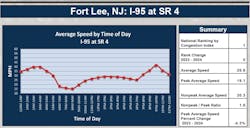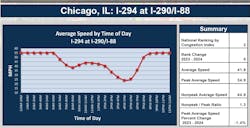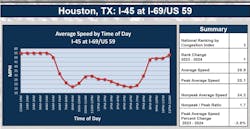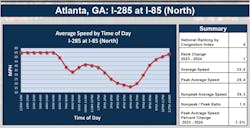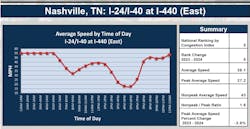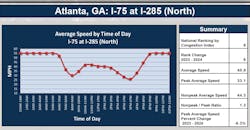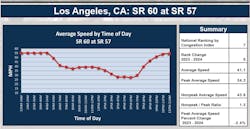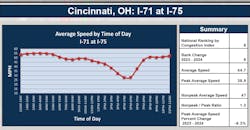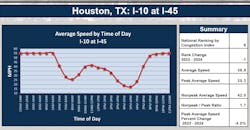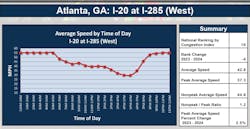The nation's most congested points for trucks continue to worsen, according to American Transportation Research Institute's report on the most congested truck bottlenecks. However, the work of some local policymakers appears to have paid off as one long-troublesome trucking bottleneck fell out of the top 10 this year.
About ATRI’s congestion research
ATRI conducts truck GPS data research in support of the U.S. Department of Transportation’s Freight Mobility Initiative. The initiative maintains an ongoing database on the national transportation system’s performance and impacts. ATRI has provided truck GPS data for the initiative since 2002.
Truck bottleneck analysis is one of the many ways ATRI utilizes its truck location dataset. The research provides unparalleled insight for public and private planners, focused specifically on trucking’s transportation needs.
Congestion costs commercial trucking billions of dollars annually. A slowed or stopped truck burns time, money, and fuel. The institute's 2024 report on the cost of congestion estimated that its delays and idling cost the industry about $108 billion.
ATRI’s 2025 Top Truck Bottleneck List measures the top congestion zones by using custom analysis to process terabytes of data from trucking operations and freight trucks’ GPS data. The institute’s analysis builds an impact ranking system for truck-involved congestion at more than 325 locations on the national highway system.
“Delays inflicted on truckers by congestion are the equivalent of 436,000 drivers sitting idle for an entire year,” Rebecca Brewster, ATRI’s president and COO, said. “These metrics are getting worse, but the good news is that states do not need to accept the status quo. Illinois was once home to the top bottleneck in the country, but following a sustained effort to expand capacity, the Jane Byrne Interchange in Chicago no longer ranks in the top 10. This data gives policymakers a road map to reduce chokepoints, lower emissions, and drive economic growth.”
The Jane Byrne Interchange was once the number one truck bottleneck in the country for three years in a row. The interchange, I-290 at I-90/I-94, now ranks No. 14 in ATRI's top 100. New construction improved rush hour truck speeds by almost 25%.
See also: Top carriers slash spending to focus on pricing power
While Chicago’s famous interchange is no longer among the top 10 bottlenecks, the city's Tri-State Tollway remained No. 2 on the list. It fell right behind the reigning worst bottleneck in the U.S. in Fort Lee, New Jersey, where I-95 connects the Garden State to Manhattan via the George Washington Bridge.
The only new city in the 2025 top 10 is Cincinnati, where I-75 and I-71 meet. This bottleneck is ranked No. 8 this year, rising from No. 14 in 2024. Cincinnati's addition to the Top 10 replaces I-55 in Chicago, which tumbled 18 spots from No. 3 in 2024 to No. 21 this year.
The rest of the Top 10 includes three spots in Atlanta, two in Houston, and locations in Nashville and Los Angeles.
1. Fort Lee, New Jersey: I-95 at SR 4
For the seventh year in a row, the nation’s top truck bottleneck is once again just outside New York City in Fort Lee, New Jersey: The intersection of Interstate 95 (Palisades Interstate Parkway) and state Route 4 has an average speed of 26 mph. At 8:00 a.m., the intersection slows to a crawling average speed of 15 mph.
2. Chicago, Illinois: I-294 at I-290/I-88
The southern portion of Illinois’s Tri-State Tollway once again ranked top 10, rising from third most impactful in 2024. Illinois is currently reconstructing much of I-294, including the infamous interchange, to provide congestion relief. The project is scheduled to be completed in 2026.
3. Houston, Texas: I-45 at I-69/US 59
During the evening, average truck speeds for this section of I-45 remain around a steady 55 mph. During daytime congestion, however, the interchange cannot accommodate traffic: Average truck speeds drop below 20 mph. Overall, the section’s average speed is 30 mph. Texas has the most congestion zones for trucking of any state, holding 12 of the top 100 bottlenecks, mostly around I-45 and I-10.
4. Atlanta, Georgia: I-285 at I-85 (North)
This section of I-285 has an average speed of 35 mph. While truck speeds are normal after midnight, daytime traffic overwhelms the area and slows speeds to below 20 mph. Georgia has the second most congestion zones among U.S. states, with nine of the top 100 bottlenecks. Nearly all of Georgia’s top bottlenecks occur near Atlanta along I-285, I-75, and I-20.
5. Nashville, Tennessee: I-24/I-40 at I-440 (East)
This section of I-24 near Nashville sees average speeds around 38 mph but has its worst traffic dip around 5:00 p.m. The afternoon rush hour regularly slows trucks below 20 mph. Tennessee’s sections of I-24 and I-40 appear in ATRI’s top 100 bottlenecks seven times.
6. Atlanta, Georgia: I-75 at I-285 (North)
This section of I-75, the second-worst bottleneck near Atalanta, is less extreme than the top five congestion zones. The average truck speed near this interchange is 41 mph. While speeds suffer during morning and afternoon congestion, trucks’ slowest average speed remains above 25 mph.
7. Los Angeles, California: SR 60 at SR 57
This section is the worst interchange between two state routes. Average truck speeds suffer most in the afternoon rush hour, slowing below 30 mph. California has eight of the top 100 bottlenecks, with most congestion occurring around Los Angeles.
8. Cincinnati, Ohio: I-71 at I-75
Truck speeds for this section of I-71 average 45 mph, suffering most congestion in the afternoon. Around 4:00 p.m., trucks often slow down below 30 mph.
9. Houston, Texas: I-10 at I-45
This section of I-10 is another I-45 interchange in the Houston area to suffer from severe congestion. Trucks average 37 mph, slowing to 25 mph in the morning rush and below 20 mph in the afternoon rush.
10. Atlanta, Georgia: I-20 at I-285 (West)
The tenth worst bottleneck for truck freight again goes to an Atlanta-area interchange. This section of I-20 fosters an average truck speed of 43 mph, suffering most congestion around 5:00 p.m. as trucks slow to around 30 mph.
About the Author
Jeremy Wolfe
Editor
Editor Jeremy Wolfe joined the FleetOwner team in February 2024. He graduated from the University of Wisconsin-Stevens Point with majors in English and Philosophy. He previously served as Editor for Endeavor Business Media's Water Group publications.

